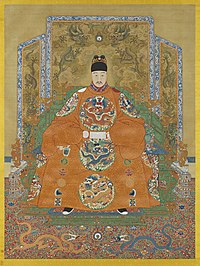| New Governance of Longqing | |||||||
|---|---|---|---|---|---|---|---|
 The Longqing Emperor (r. 1567–1572) The Longqing Emperor (r. 1567–1572) | |||||||
| Traditional Chinese | 隆慶新政 | ||||||
| Simplified Chinese | 隆庆新政 | ||||||
| |||||||
The New Governance of Longqing was a period of peace that occurred during the reign of the Longqing Emperor. During his reign, Longqing was used as the reign title. The Longqing Emperor had previously resided in a princely residence outside the palace before ascending to the throne. This allowed him to better understand the sentiments of the people and carefully select trustworthy individuals to serve in his government. These individuals included civil officials such as Xu Jie, Gao Gong, Zhang Juzheng, and Yang Bo (楊博), as well as military officers like Tan Lun, Wang Chonggu (王崇古), Qi Jiguang, and Li Chengliang. This period saw relative stability in society and an improvement in the economy compared to the previous Jiajing era. Later historians referred to this period as the "New Governance of Longqing".
After the Longqing Emperor ascended the throne, Senior Grand Secretary Xu Jie and Zhang Juzheng jointly drafted the posthumous edict of the Jiajing Emperor. This edict aimed to correct the abuses of fasting and large-scale building projects during his reign and to restore the positions of diligent court officials who had been wrongly accused. However, in 1569, after Gao Gong returned to power, he vigorously opposed Xu Jie's actions and reevaluated the Jiajing Emperor. This put an end to hasty reversals without thorough investigation. As a result, a good relationship between the ruler and his ministers was established, creating a positive political atmosphere and providing a foundation for further reforms.
In 1567, the Longqing Emperor announced the end of the maritime ban and made adjustments to overseas trade policies. This allowed private individuals to engage in trade both east and west, a significant event known as the "Longqing Opening" (隆慶開關) in historiography. As a result, private overseas trade gained legal status and reached its peak along the southeastern coast, leading to a relatively comprehensive opening in the Ming dynasty. Chinese scholar Wang Yuxun analyzed that from 1567 to 1644, approximately 330 million taels of silver flowed into the Ming dynasty from overseas. This amount was equivalent to one-third of the world's total silver production at that time.
In response to the border issues during the reign of the Jiajing Emperor, the imperial cabinet proposed strengthening the defense of the northern border by repairing and fortifying the Great Wall, improving military defense capabilities, and implementing a new flexible strategy and tactics for border defense. By the end of 1570, the Ming dynasty and the Mongols, who had been engaged in a hostile war for two hundred years, reached a tribute agreement known as the "Tribute of Altan Khan" (俺答封貢) in historiography. This agreement came after Daicing Taiji (把漢那吉) surrendered to the Ming, marking the end of the long-standing conflict and allowing the northern border of the Ming dynasty to finally rest and recuperate. As a result, for the next hundred years, there were no large-scale wars between the two sides.
References
- "千古一相——张居正之生平介绍". 荊州市張居正研究會 (in Chinese). Archived from the original on 4 January 2014. Retrieved 3 January 2014.
- 趙, 世明 (2008). "《高拱"尽反阶政"浅析》". 《殷都學刊》 (in Chinese) (01期). 天水師範學院文史學院.
- "高拱研究60年:回顾与展望" (in Chinese). 國學網. Archived from the original on 4 January 2014. Retrieved 3 January 2014.
- "中华文明历史题材美术创作工程"选题及简介" (in Chinese). 復旦大學儒學文化研究中心(The Center for Confucian Culture Studies of Fudan University). Archived from the original on 3 January 2014. Retrieved 3 January 2014.
- "戳穿清朝盛世的骗局" (in Chinese). 中國國學網. Archived from the original on 8 January 2014. Retrieved 3 January 2014.
- 全, 太錦. "明蒙隆庆和议前后边疆社会的变迁 ——以大同和丰州滩之间碰撞交流为中心" (in Chinese). 中國蒙古學信息網. Archived from the original on 3 January 2014. Retrieved 3 January 2014.
- 胡, 凡. "论明穆宗时期实现"俺答封贡"的历史条件" (in Chinese). 中華文史網. Archived from the original on 8 May 2021. Retrieved 3 January 2014.